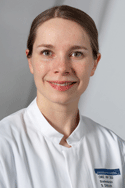Matthias Zielonka, MD
Matthias is a physician scientist in the Division for Neuropediatrics and Metabolic Medicine at the Center for Child and Adolescent Medicine of Heidelberg University.
Biography:
Medical licensing exam, approbation; 2012
Residency in General Pediatrics at the Center for Child and Adolescent Medicine, Heidelberg University; since 2012
MD thesis, Max-Planck-Institute for Heart and Lung Research, Bad Nauheim & Heidelberg University; 2014
Fellow of the Physician-Scientist-Program, Medical Faculty of Heidelberg University; 2015-2017
HRCMM Career Development Fellowship 2017 – 2018
Clinical host: Prof. Dr. med. Georg F. Hoffmann, Center for Child and Adolescent Medicine, University Hospital Heidelberg
EMBL host: Prof. Dr. Matthias Hentze, Directors’ Research, RNA Biology, Metabolism and Molecular Medicine
Disease studied: Inborn Errors of Metabolism
Inborn errors of metabolism constitute a heterogeneous group of various enzyme deficiencies. Although inborn errors of metabolism are individually rare, their cumulative prevalence is estimated to be around 1:500, defining them as highly common and relevant causes of morbidity and mortality in children and adolescents. In the current concepts for inborn errors of metabolism, specific diseases are caused by mutations leading to a dysfunction of the catalytic site of a respective enzyme, thereby blocking intermediary metabolic pathways. In general, this enzymatic dysfunction results in the accumulation of toxic or complex metabolites and/or depletion of essential end products, ultimately causing a specific dysfunction and, subsequently, a mono- or multisystemic clinical phenotype. However, clear genotype-phenotype correlations are often poor and treatment options predominantly limited, which emphasizes that the understanding of the pathophysiological bases of this group of inherited diseases still remains restricted.
This project aims at elucidating the underlying pathomechanisms of selected inherited metabolic diseases to ultimately improve current and develop new diagnostic and therapeutic strategies. By combining both biochemical and system level approaches, Matthias wants to define genotype-phenotype-correlations of specific mutations in vitro and establish a zebrafish model to study morphological, biochemical as well as genetic alterations contributing to the phenotypic presentation of defined inborn errors of metabolism in vivo. Since several enzymes of intermediary metabolism have been shown to be involved in RNA-binding, one major aim of this project is the exact characterization of RNA-binding enzymes, the investigation of the role of RNA-binding in the context of intermediary metabolism and their pathomechanistic relevance for the respective diseases.
Awards:
February 2018: Urea Cycle Disorders Consortium (UCDC) Training Research Award 2018/2019 from the Baylor College of Medicine, USA
August 2018: Rare Disease Scholars Program 2018/2019 from the Children’s National Health System, USA
Publications:
Severity-adjusted evaluation of newborn screening on the metabolic disease course in individuals with cytosolic urea cycle disorders.
Posset R, Kölker S, Gleich F, Okun JG, Gropman AL, Nagamani SCS, Scharre S, Probst J, Walter ME, Hoffmann GF, Garbade SF, Zielonka M; Urea Cycle Disorders Consortium (UCDC) and the European registry and network for Intoxication type Metabolic Diseases (E-IMD) consortia study group.
Mol Genet Metab. 2020 Dec;131(4):390-397. doi: 10.1016/j.ymgme.2020.10.013. Epub 2020 Nov 7. PMID: 33288448
Chronic hyperammonemia causes a hypoglutamatergic and hyperGABAergic metabolic state associated with neurobehavioral abnormalities in zebrafish larvae.
Probst J, Kölker S, Okun JG, Kumar A, Gursky E, Posset R, Hoffmann GF, Peravali R, Zielonka M.
Exp Neurol. 2020 Sep;331:113330. doi: 10.1016/j.expneurol.2020.113330. Epub 2020 Apr 25. PMID: 32339612
Long-term effects of medical management on growth and weight in individuals with urea cycle disorders.
Posset R, Garbade SF, Gleich F, Gropman AL, de Lonlay P, Hoffmann GF, Garcia-Cazorla A, Nagamani SCS, Baumgartner MR, Schulze A, Dobbelaere D, Yudkoff M, Kölker S, Zielonka M; Urea Cycle Disorders Consortium (UCDC); European registry and network for Intoxication type Metabolic Diseases (E-IMD).
Sci Rep. 2020 Jul 20;10(1):11948. doi: 10.1038/s41598-020-67496-3. PMID: 32686765
From genotype to phenotype: Early prediction of disease severity in argininosuccinic aciduria.
Zielonka M, Garbade SF, Gleich F, Okun JG, Nagamani SCS, Gropman AL, Hoffmann GF, Kölker S, Posset R; Urea Cycle Disorders Consortium (UCDC) and the European registry and network for Intoxication type Metabolic Diseases (E-IMD) Consortia Study Group.
Hum Mutat. 2020 May;41(5):946-960. doi: 10.1002/humu.23983. Epub 2020 Jan 30. PMID: 31943503
Early prediction of phenotypic severity in Citrullinemia Type 1.
Zielonka M, Kölker S, Gleich F, Stützenberger N, Nagamani SCS, Gropman AL, Hoffmann GF, Garbade SF, Posset R; Urea Cycle Disorders Consortium (UCDC) and the European Registry and Network for Intoxication type Metabolic Diseases (E-IMD) Consortia Study Group.
Ann Clin Transl Neurol. 2019 Sep;6(9):1858-1871. doi: 10.1002/acn3.50886. Epub 2019 Aug 30. PMID: 31469252
Ultra-orphan lysosomal storage diseases: A cross-sectional quantitative analysis of the natural history of alpha-mannosidosis.
Zielonka M, Garbade SF, Kölker S, Hoffmann GF, Ries M.
J Inherit Metab Dis. 2019 Sep;42(5):975-983. doi: 10.1002/jimd.12138. Epub 2019 Jul 24.PMID:31222755
Early prediction of phenotypic severity in Citrullinemia Type 1.
Zielonka M, Kölker S, Gleich F, Stützenberger N, Nagamani SCS, Gropman AL, Hoffmann GF, Garbade SF, Posset R; Urea Cycle Disorders Consortium (UCDC) and the European Registry and Network for Intoxication type Metabolic Diseases (E-IMD) Consortia Study Group.
Ann Clin Transl Neurol. 2019 Aug 30. doi: 10.1002/acn3.50886. [Epub ahead of print]PMID:31469252
Impact of Diagnosis and Therapy on Cognitive Function in Urea Cycle Disorders.
Posset R, Gropman AL, Nagamani SCS, Burrage LC, Bedoyan JK, Wong D, Berry GT, Baumgartner MR, Yudkoff M, Zielonka M, Hoffmann GF, Burgard P, Schulze A, McCandless SE, Garcia-Cazorla A, Seminara J, Garbade SF, Kölker S; Urea Cycle Disorders Consortium and the European Registry and Network for Intoxication Type Metabolic Diseases Consortia Study Group.
Ann Neurol. 2019 Jul;86(1):116-128. doi: 10.1002/ana.25492. Epub 2019 May 13.PMID:31018246
Bioenergetic dysfunction in a zebrafish model of acute hyperammonemic decompensation.
Zielonka M, Probst J, Carl M, Hoffmann GF, Kölker S, Okun JG.
Exp Neurol. 2019 Apr;314:91-99. doi: 10.1016/j.expneurol.2019.01.008. Epub 2019 Jan 14.PMID:30653968
Clinical characteristics of 248 patients with Krabbe disease: quantitative natural history modeling based on published cases.
Komatsuzaki S, Zielonka M, Mountford WK, Kölker S, Hoffmann GF, Garbade SF, Ries M.
Genet Med. 2019 Mar 22. doi: 10.1038/s41436-019-0480-7. [Epub ahead of print]PMID:30899093
A cross-sectional quantitative analysis of the natural history of free sialic acid storage disease-an ultra-orphan multisystemic lysosomal storage disorder.
Zielonka M, Garbade SF, Kölker S, Hoffmann GF, Ries M.
Genet Med. 2019 Feb;21(2):347-352. doi: 10.1038/s41436-018-0051-3. Epub 2018 Jun 6.PMID:29875421
Pharmacologic rescue of hyperammonemia-induced toxicity in zebrafish by inhibition of ornithine aminotransferase.
Zielonka M, Breuer M, Okun JG, Carl M, Hoffmann GF, Kölker S.
PLoS One. 2018 Sep 10;13(9):e0203707. doi: 10.1371/journal.pone.0203707. eCollection 2018. PMID:30199544
A cross-sectional quantitative analysis of the natural history of Farber disease: an ultra-orphan condition with rheumatologic and neurological cardinal disease features.
Zielonka M, Garbade SF, Kölker S, Hoffmann GF, Ries M.
Genet Med. 2017 Oct 19. doi: 10.1038/gim.2017.133. PMID:29048419
Contact: matthias.zielonka@med.uni-heidelberg.de












